of
Unknown Seas and Savage Lands.
CHAPTER I.
THE ROLLING STONE OF HISTORY.
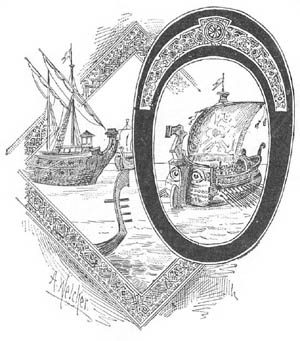 |
And if so many cities and nations have perished within the brief period that historic annals measure, how many changes must have taken place in the life of the world since the foot of man was planted by God's fiat in the Garden of Paradise? Is it unreasonable to believe that, as mankind is now distributed over all the earth, the present must be one of many like distributions? If moving glaciers from the north once swept over all Europe and North America, and destroyed all forms of life in those regions, is it not within reason to suppose that some great cataclysm, or possibly a moving field of ice from the south, may have driven animal life towards the tropics? And may we not also infer from the united evidences of lofty mountains, deep valleys, high tablelands, islands of the deep, active volcanoes and all the corrugations that now appear on the face of nature, that where land now is the ocean was once spread, and where deep seas now roll in perpetual unrest a verdant plain or forest-covered country once invited the energies of man?
RISE AND FALL OF NATIONS.
In short, we must believe that what we call discovery is but reclamation; that every new shore approached is only re-discovery; that every fresh land which the explorer beholds is only one from which an earlier foot has retreated. History, like nations, has its periods of existence; as peoples disappear so do records, and a new cycle in human affairs begins. In the years to come maybe the steamship will disappear from the sea, the engine will cease its throbs, all inventions of man may be lost; then will another era in the world's life begin: from the ocean will arise other continents; out of a savage state man will emerge again, and the evolution towards a high civilization will be renewed, just as has been done in the measureless bygone ages, and just as in the endless ages of the future will be done again.
As ruins of what were once great cities give indisputable evidence of their former existence, though history may not tell us how they were destroyed, we will now undertake to show that the new countries discovered by navigators in the past five centuries were formerly well known, though we cannot understand the cause that destroyed this knowledge and left them to be re-discovered.
CAVE-DWELLERS WHO BECAME MASTERS OF THE WORLD.
In the region of Arabia we find the earliest traces of man. On the Euphrates he is believed to have had his birth, and from Ararat Genesis tells us Noah stepped forth upon dry land after the flood had drowned all except his own family. It is, therefore, no strange thing that in this region, along the Red Sea, navigation should have had its beginning. We are told that in a very early period of antiquity, the age of which cannot be set down, there existed on the shores of the Red Sea a race of people who dwelt chiefly in caves among the hills of the sea coast and subsisted by fishing; whatever attempts they made at erecting habitations were confined to the rudest possible structures, such as the laying of a few branches together that would scarce give protection either from sun or rain. They were known in the earliest times as Horites and Children of Anak, both of which designations have reference to their living in holes and caves. The Grecian name of Troglodytes, with which we are so familiar, is but a translation of the same name. But they were also called fish-eaters, locust-eaters, and wood-eaters, which is a manifest indication that they were separated from all, other tribes. Being thus isolated, and regarded as robbers or savages, and dependent upon the sea for their livelihood, they became inventive in applications for taking fish and undertaking voyages. Their earliest boats were made of reeds or papyrus, or other light material, cemented together with pitch. References are made to these people by Job and other very early writers. For some reason, which is not recorded in history, they finally emigrated from the shores of the Red Sea and settled in the land of Canaan. The father of these ancient peoples is known as Canaan, from which the word Canaanite is derived. Finding the country exceedingly fertile, they began pastoral pursuits, that portion of the country extending from the Mediterranean to Lake Gennesaret being given over to that occupation. A much larger portion occupied the Mediterranean shores, and, beginning their. pursuits of fishing, made larger boats than they had used on the Red Sea, and out of these evoluted the ships with which they made voyages to adjacent lands. They soon became known to the Greeks, whose country they visited, and by these were given the name Phoenicians, a designation derived from the Greek word for palms, great numbers of which grow in the Holy Land.
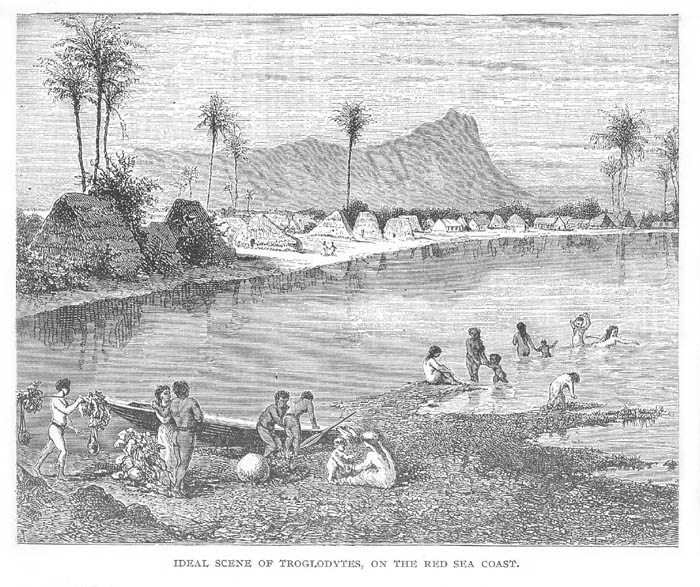 |
The Phoenicians were a nation distinguished for their spirit of freedom and independence, by which they were alike actuated in Canaan and on the shores of the Red Sea; and being surrounded by hostile peoples, in the country to I which they had emigrated and prospered they built great walled cities and immense fortifications,-in which they found a perfect protection. Their commerce extending, they soon carried commodities to Egypt and to Greece, and to other nations occupying territory in the Levant. In the beginning of their navigation on the Mediterranean they made use of long ships, understanding the means of ballasting them so as to provide security in case of storms, and, becoming familiar with the other nations of the country, they were soon looked upon as the most advanced people in the old world. For about six hundred years after Noah, the navigation
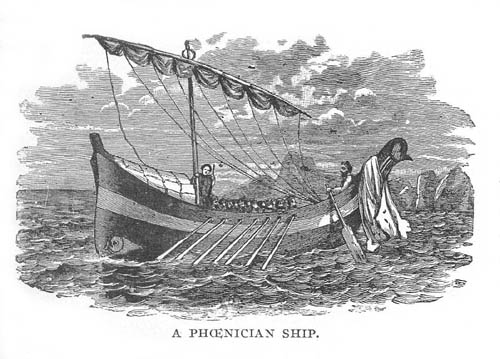 |
While the best proofs that we are able to recover from history give the, Phoenicians the credit of being the earliest navigators, there are other peoples who lay claim to the honor, the Greeks, the Egyptians, the Indians, each asserting that they were the earliest navigators and offering more or less evidence in support of their pretensions. The people of India, or of China, set forth the claim that more than 2000 years before the time of Christ they had sailed along the entire coast of China, discovering the Islands of Japan, the East Indies, and directly after, making a passage through the Pacific Ocean, landed at Peril; and that they also crossed Brazil and set out in new ships for the Antilles to which they maintain themselves to be the first discoverers. There are some old records in China which seem to support these claims, and in which we read descriptions of the peoples of the New World, as the Chinese had found them; but they are so mixed with legend, and tradition, and myths, that little dependence can be' placed upon any of the statements contained in the record.
DISCOVERIES OF THE ANCIENTS.
Berosus says that in the year 143 after the flood, Tubal came by sea to Spain; but he neglects to give any particulars of the voyage, undoubtedly because there are no records from which to gain the information; but his statement certainly rests upon some tradition which he had heard. Diodorus Siculus makes the assertion that, shortly after this time, Queen Semiramis made an expedition into India, and in the mouth of the river Indus gave battle to king Spabrobates and destroyed a thousand of his ships. We have another statement from Berosus that in 650 years after the flood, there was a king in Spain named Hesperus, who in his time made a voyage upon the ocean and discovered Cape Verde and the Island of St. Thomas; and Gonsalvo Hernandes, a chronicler of antiquities, affirms that in his time the Islands of the West Indies were discovered, and called after this king's name Hesperides, in proof of which statement we have the report that these islands were discovered in a forty day's sail from Cape Verde, in which time the passage might be easily made by the aid of favorable winds. More or less confusion necessarily arises out of the fact that there have been astonishing changes of the sea and islands in the past thousand years.
The old geographers, as well as early navigators, located-a large number of islands and gave to them names with which we are no longer familiar. But that a great many islands were discovered which have since disappeared there can be no doubt. The fact, therefore, that we have mention of such islands as those of Hesperides, De Principe, Antilles, Fortunate Islands, and hundreds of others, leads us into many difficulties; because some of these islands are now known to exist, while evidence of others is wanting. These may have subsided under the effects of great cataclysms, such as is believed to have destroyed the vast strip of land which is supposed to have at one time connected Africa and South America. Pliny observes that it is recorded in history (which however he neglects to name) that near the Straits of Gibraltar there was formerly an island called Aphrodisias, thickly inhabited and planted with many orchards and gardens, and showing other evidences of. great prosperity and a high civilization. This island was known as Cadiz. But we have been unable to find any other mention made of it, and though it is said to have at one time joined with Spain, deep sea soundings now fail to show any such island or the probability of there having been one. The Islands of the Azores were also at one time said to join the mainland, and on which was a large town called Syntra. This has also disappeared. Eratosthenes states that Spain and Barbara were at one time connected, and that the Islands of Sardinia and Corsica were Joined by a considerable strip of land, as was also Sicily with Italy, and Negro Ponto with Greece; and accounts have been given of the finding of the hulls of ships and iron anchors upon the mountains of Switzerland, very far from land, though that the sea could have ever swept in and covered mountain peaks so lofty at a comparatively recent date is a matter impossible of belief.
The land of Malabar, which is now a part of India and thickly settled, was at one time under the sea, while Cape Cormoran and the Island of Zealand were connected and composed one large body of land. Malacca and Sumatra were also joined, as is shown by Ptolemy's frequent references thereto. So also did Sumatra and Java unite to form one very long island, while Borneo was connected with the mainland. These changes in the face of the land and sea within the period of history will necessarily confuse the reader when references are repeatedly made to the islands by the names by which they were originally designated.
THE COMMERCE OF TROY WITH INDIA.
Troy is believed to have been founded 800 years after the flood, the people of which are said to have brought from India, by way of the Red Sea, spices, drugs, and other merchandise, and to have exchanged with the Indians purples, linens, and other manufactured articles. A city called Arsinoe was at that time located where the modern Suez stands, and this place was a great port of entry for vessels passing out of the Mediterranean and Red Seas on the voyage to India. From this city also started caravans overland from northern Africa to cross Arabia; so that, though small mention is made of the place in history, these facts are sufficient to lend plausibility to the statement that it was a city of considerable commercial importance.
Sesostris, king of Egypt, 900 years after the flood and some time before the destruction of Troy, caused a canal to be cut between the Red Sea and an arm of the Nile entering the river where the city of Heroum then stood. The building of this canal was conclusive evidence that a very large number of ships sailed constantly to and from India and the, ports of the Mediterranean.
By Strabo we also learn that King Menelaus, after the destruction of Troy, sailed out of the Straits of Gibraltar, coasted Guinea and Africa, and proceeded thence eastward to India, this being the first account we have of any circumnavigation of Africa. Neco, king of Egypt, sent an expedition to discover a passage through the Red Sea about the time that Menelaus dispatched an expedition by way of the west around Africa. The vessels of Neco passed out of the Mediterranean into the Red Sea, and sailing down the coast of Africa, continued until they had doubled the cape, passing up the westward coast, and again entered the Mediterranean at Gibraltar. Thus was Africa circumnavigated by two fleets, sailing in opposite directions, at nearly the same time.
SOLOMON'S NAVY.
Thirteen hundred years after, the flood, as the Bible tells us, Solomon built a very large ,navy on the Red Sea at a haven called Ezion Geber, from which a voyage was made to the islands of Tharsis and Ophir. This fleet was absent three years on its voyage, and returning each vessel brought a rich cargo of gold, silver, and precious wood. Many historians maintain that this fleet sailed to Peru where the riches brought back by them were obtained, while equally creditable writers believe that the voyage was to the kingdom of Sofala on the East Africa coast, and ruled over by the Ethiopic queen Sabea, or Sheba.
Aristotle tells us that in the year 590 before Christ, the Carthaginians sent out a fleet of several vessels, which sailed westward until they discovered the West Indies and New Spain. Whether they sailed along the coast of Brazil or entered upon an exploration of the Antilles, we are not told. Unfortunately, the records in all these cases are exceedingly brief, being no more than a bare mention of facts.
Xerxes, king of Persia, 485 years before Christ, sent his nephew, Sataspis, on a voyage in a search of a route to India. The nephew sailed out of the straits and proceeded southward along the coast as far as Guinea. But his superstitious fears being excited on account of a wind which prevailed several days in a favorable direction, which he feared would carry him over the edge of the world, he turned back, and forfeited his life to the irate king in consequence.
HAMILCAR'S VOYAGE TO THE NORTH SEAS.
Himilco, or Hamilcar, and Hanno his brother, 443 years before Christ, both Carthaginian generals, but at the time residing in a portion of Spain now called Andalusia, set out on two voyages. Himilco sailed towards the north, and discovered the northern coast of Spain, France, England, Holland and Germany. It is also believed that he proceeded as far north as Iceland. He was absent two years, and attained a latitude where the cold was so severe that he came near perishing with his crew. He certainly discovered some island in the extreme north to which has since been given the name of Purgatory of St. Patrick, because he found people thereon who received him with signs of hostility, which they manifested by cries and groans. He states that the island had three volcanoes which continually belched forth fire, but that, strange enough, the fire which emanated from one of these would not burn, while that from another would consume even earth itself. He also relates that he discovered there two fountains, one of which was like melted wax and always boiling, and anything thrown therein would be almost immediately turned into stone. He noticed on the island also such animals as bears, foxes, hares, crows, falcons, and other birds and quadrupeds, and also cattle, while the grass grew so rapidly that it yielded several harvests each year and was so succulent, that the cattle browsing thereon had to be forcibly taken from their repasts to prevent them from bursting. He describes also having seen most remarkable fish, not only mis-shapen, but of such enormous size that from their bones and ribs a church had been built, and that a sight of one of these monstrous fish frightened his mariners into a condition of panic.
ASTOUNDING ADVENTURES OF HANNO.
Hanno, the other brother, sailed along the African coast southward and discovered the Fortunate Islands, which might be the Canaries, and others, such as Dorcades, Hesperides, and the Gordades, which are now called the Cape Verde Islands. He was absent for a period of five years, discovering a great many islands and countries, and giving names to them, but which fail to designate any present known lands. He also reports meeting with strange adventures
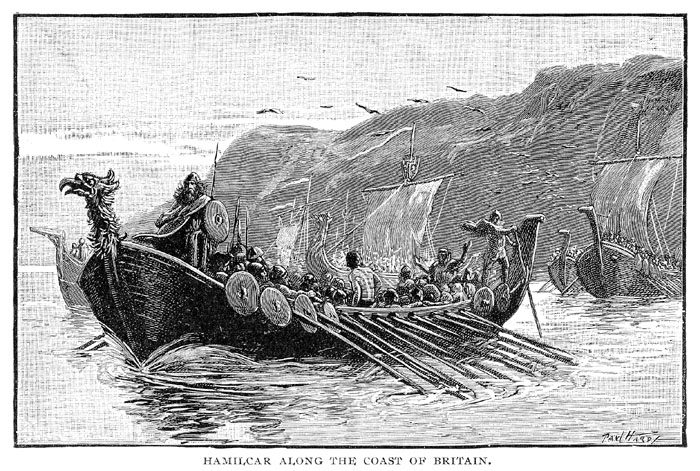 |
At Cape Bona Sperenca (Esperanza), Hanno came in contact with a people who he declares were great witches and enchanters of snakes, which they brought into their service and placed as sentinels to guard their churches and grave-yards, and cattle, and other possessions. He asserts that the people declared to him that any invaders of their property would be immediately attacked by the snakes, which, winding themselves about them, would hold them prisoners until the master came to punish the trespassers. In case the invasion was made by some large quadruped, as elephant, rhinoceros, lion, or other dangerous beast, Hanno states that these sentinel snakes would proceed at once to the hut where the master lived, and give information of the dangerous presence by stroking him. He relates also a curious incident, that while one of his men was lying in a hut in a native village, he heard a great noise as if some one was striking heavy blows, which inducing him to rise, he went out and demanded the cause of the disturbance. Thereupon he was answered by one of the natives, that it was his cobra snake that had been calling him.
AMONG THE MERMAIDS.
Upon the sea coast, this courageous explorer also maintains to have found certain fishes which swam upright in the water, and had both the faces and natures of women, and with whom the fishermen of the coast became so well acquainted and familiar that these mermaids were frequently induced to come on shore and occupy the huts of the natives for a time.
Hanno, at the expiration of five years, completed a circumnavigation; of Africa, and made report of all the astonishing things which he had seen, for which his king rewarded him in the most generous manner, and caused his name to be perpetuated in the history of his country.
VOYAGE OF PYTHEAS, THE PHILOSOPHER.
The Greeks became active in discovery and an extension of their commerce by sea in the fourth century before Christ, and about 340 B.C. they sent out an expedition under the navigator and philosopher, Pytheas, of Marseilles (the ancient Masillia of the Ionians). The real purpose was to follow the fleet of Hamilcar, and to discover, if possible, the source from which the Carthaginians secured their great stores of tin and amber, which Hamilcar was known to bring from some region in the north-west. Much was expected of Pytheas, who was distinguished for his knowledge of astronomy and who was first to ascertain the moon's influence on the earth and the true cause of the tides, nor was such expectation disappointed. He was not able to find the tin mines of Britain; but continuing his voyage northward, he found along the shores of Norway vast deposits of amber, which he reported the people of that country burned instead of wood. He also declared that amber was "a coagulated matter cast up by the sea," a statement which gave creation to the superstition that this substance was the petrified tears of sorrowing sea-birds, as Tom Moore relates in his Lalla Rookh; and again, as the tear drops shed by the sisters of Pha�thon, the giddy youth who having received permission of Sol (the Sun) his father to drive his chariot one day, started out at such a pace that he set the world on fire, and was drowned in the river Po for his recklessness. Amber has since been ascertained to be a vegetable resin, that exuded from forest trees which are now extinct, and which is found in large deposits in many parts of Scandinavia, attached to fossilized trees which form a stratum of bituminous woods beneath beds of sand and clay.
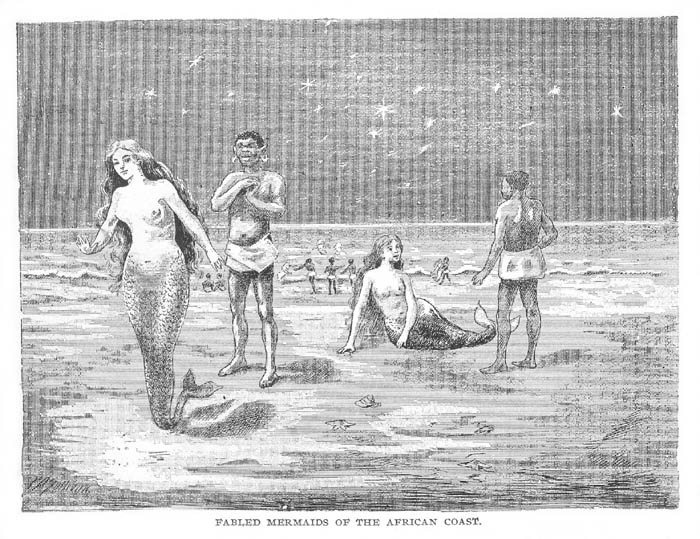 |
A WONDROUSLY PROFITABLE COMMERCE.
Strabo and Pliny both make mention of an enormously profitable trade being inaugurated by Ptolemy Philadelphus, King of Egypt, between his country and India, which resulted in making Alexandria the richest city in the world. In the time of this king (300 B.C.) this traffic is said to have yielded annually in customs alone the enormous sum of seven millions and a half of gold, according to the authority of Strabo. If crowns are meant, the sum in American money was $43,500,000. This is almost inconceivable, yet the same writer declares that a few years later, when Rome became master of Egypt, the custom revenues from this trade with India was doubled, and that one hundred and twenty ships were engaged in the commerce, which made the trip in a year. Pliny, dwelling on the magnitude of the exchange, confirms the statements of Strabo, for he says: "The merchandise which these ships carried amounted to 1,200,000 crowns ($6,960,000) and there was made in return of every crown an hundred. In so much, that by reason of this increase of wealth the matrons, or noble women, of that time and place spent infinitely (fabulous sums) in decking themselves with precious stones, purples, pearls, gum, benzoin, frankincense, musk, amber, sandalwood, aloes, and other perfumes, and trinkets and the like."
A NORTH-WEST PASSAGE.
If our profound surprise be excited by a recovery from ancient history of the fact that there was a profitable maritime commerce carried on between ports of the Mediterranean and India, and that the Red and Mediterranean seas were connected by a canal to facilitate this trade, while as late as the 15th century the ambition of navigators was directed towards finding a water route to India, how much greater must our astonishment be to learn that a northern passage from Europe to India was accomplished 200 years before the birth of Christ.
Strange as the statement may appear, we have it upon the authority of Antonio Galvano, the Portuguese historian, that the Romans, having made themselves masters of all Europe, Northern Africa, and the countries of Western Asia, sent an expedition of many sail against the Khan of Cathay (China), which country had been represented to them as abounding in wealth, and hence promising great spoil to successful invaders. The ships carried a large army prepared for any dangerous enterprise, and sailing out through Gibraltar took a northerly course, and passing by the English and Shetland shores, the great tin mines from which the Carthaginians procured their supplies of tin were re-discovered. The expedition continued northward, and rounding the coast of Norway, set their course directly eastward. Thus they continued to Behring Strait, through which they sailed, and finally reached Cathay which the Roman soldiers successfully invaded. The Khan was defeated in every battle, cities were looted and then destroyed, and lading their vessels with the treasure captured the Romans returned to their own country by the southern route.
DESTRUCTION OF THE ROMAN EMPIRE.
The Romans continued to rule the world and carried on an overland trade with India and China, until their own country wag invaded by the Norsemen and Moors in about 412 A.D. when Rome capitulated. The Romans continued to wage war against the invaders, however, until 474 when the Empire passed into the hands of the fierce Norsemen.
For several hundred years the spirit of discovery had been quiescent, the far outlying lands were neglected because they had not been a source of revenue, and in the long lapse of time they were forgotten. History was but a puling infant, geography was in a nebulous state, the world was only emerging from savagery, hence we cannot be surprised that the splendid discoveries of the ante-christian period should in a large measure be lost again to the nations that made them.
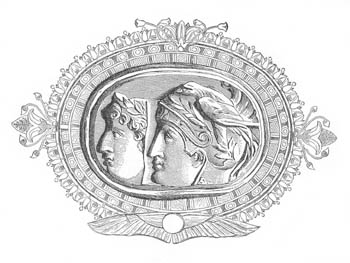 |